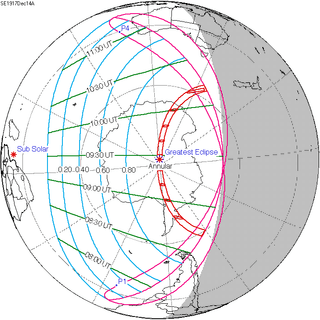Solar eclipse of May 18, 1920
| Solar eclipse of May 18, 1920 | |
|---|---|
 Map | |
| Type of eclipse | |
| Nature | Partial |
| Gamma | -1.0239 |
| Magnitude | 0.9734 |
| Maximum eclipse | |
| Coordinates | 69°06′S 107°42′E / 69.1°S 107.7°E |
| Times (UTC) | |
| Greatest eclipse | 6:14:55 |
| References | |
| Saros | 146 (22 of 76) |
| Catalog # (SE5000) | 9328 |
A partial solar eclipse occurred on May 18, 1920. A solar eclipse occurs when the Moon passes between Earth and the Sun, thereby totally or partly obscuring the image of the Sun for a viewer on Earth. A partial solar eclipse occurs in the polar regions of the Earth when the center of the Moon's shadow misses the Earth.
Related eclipses
Solar eclipses 1916-1920
Each member in a semester series of solar eclipses repeats approximately every 177 days and 4 hours (a semester) at alternating nodes of the Moon's orbit.
| Solar eclipse series sets from 1916–1920 | ||||
|---|---|---|---|---|
| Ascending node | Descending node | |||
| 111 | December 24, 1916 Partial |
116 | June 19, 1917 Partial | |
| 121 | December 14, 1917 Annular |
126 | June 8, 1918 Total | |
| 131 | December 3, 1918 Annular |
136 | May 29, 1919 Total | |
| 141 | November 22, 1919 Annular |
146 | May 18, 1920 Partial | |
| 151 | November 10, 1920 Partial | |||
Notes
References
- Earth visibility chart and eclipse statistics Eclipse Predictions by Fred Espenak, NASA/GSFC
External links
| Wikimedia Commons has media related to Solar eclipse of 1920 May 18. |
This article is issued from
Wikipedia.
The text is licensed under Creative Commons - Attribution - Sharealike.
Additional terms may apply for the media files.
